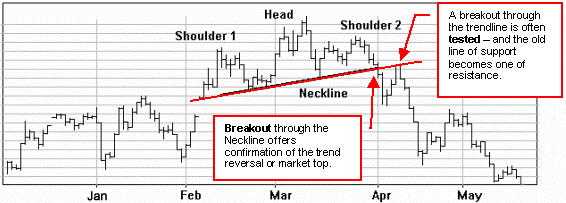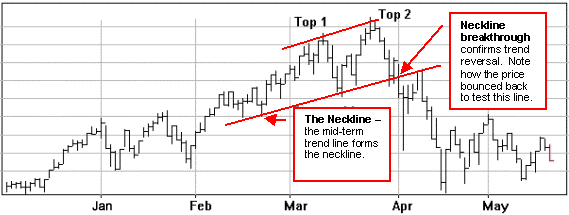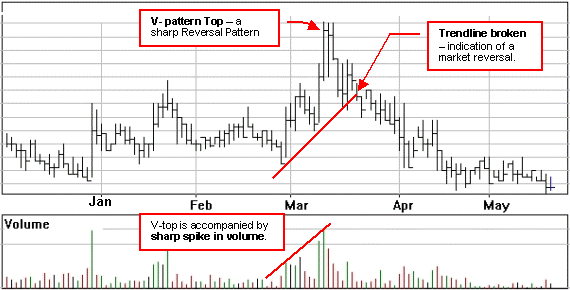Reversal Patterns
(Tops And Bottoms)
Reversal patterns, or tops and bottoms, signify a
fundamental change in the long term trend.
Overview
- Tops are usually less stable and shorter than bottoms.
- Bottoms usually have smaller price variations and are slower to
establish.
- Volume is usually more important on the upside.
- Confirmation of a top or bottom is in a double top or bottom (or
a short channel.)
The most popular Reversal Patterns include: head and
shoulders, double tops and bottoms, triple tops and bottoms, and
V-formations.
Interpretation & Signals
Head & Shoulders

The well known head and shoulders pattern is formed by
three peaks; the center peak, or head, is slightly higher than two
lower, and not necessarily symmetrical, shoulders. The line joining the
bottoms of the two shoulders is called the neckline. Due to
fluctuations, the neckline is rarely symmetrical or perfectly
horizontal.
The pattern isn't complete until the neckline is broken.
It is often good to wait for confirmation - for example, two successive
closes below the neckline. Remember, markets often bounce back to the
Neckline after the breakout and this becomes a new level of resistance.
Volume should be assessed to confirm the validity of
these patterns. Volume is normally heaviest during the formation of the
left shoulder and also tends to be quite heavy as prices approach the
peak. The real confirmation of a developing Head and Shoulders pattern
comes with the formation of the right shoulder, which is invariably
accompanied by distinctly lower volume.
Some traders use the distance between the neckline and
the top of the head to project a "price objective." The
price objective is determined by measuring from is the top of the head
to the neckline, and using this distance from the breakout point
downwards.
An Inverted Head and Shoulders
pattern is a mirror image of the Head & Shoulders pattern (forming a
market bottom).
Double Tops

Double Tops are another reliable and frequently
used reversal pattern. This pattern consists of two tops of
approximately equal height. A line is drawn below and parallel to the
resistance line that connects the two tops. The neckline is a strong
support for price level but eventually fails.
As with a Head and Shoulders, after the two rallies and
their respective reversals are completed the double tops is confirmed
only when the neckline is broken. The support line then becomes a
resistance line, which often holds a market rebound.
A Double Bottom pattern is a mirror image of a double
top pattern: The average height of the bottoms gives a good indication
of the price objective.
Triple Top
A tnple top is a cross between a head and
shoulders and double top. This formation consists of three tops
of approximately equal height. A line is drawn below and parallel to the
resistance line that connects the three tops. The neckline is a strong
support for price level but eventually fails. The support line then
becomes a resistance line, which usually holds any market rebound.
Triple Bottom
A triple bottom pattern is a
cross between an inverted head and shoulders and double bottom pattern.
V- Pattern
The V pattern is an unusual pattern in that a sharp
trend switches from one direction to the other without warning and with
high volume at or just after the turn around.

Further points
Trend reversals offer some of the most important
opportunities for entering a market with a good profit potential. They
usually represent fundamental changes in the underlying character of a
particular market and often go on to yield big moves.
However, a market top or bottom is often difficult to
identify. It is even more difficult to choose appropriate entry and
exit points. One problem is distinguishing between an actual change in
trend or merely a congestive phase in the middle of a move. It is
usually advisable to wait for prices to actually confirm a trend
reversal by developing one of these well-tested and reliable reversal
patterns. The actual buy or sell signals are based on a breakout in the
direction of the new trend.
Here are some general observations about Reversal
patterns:
- A breakout through a trend line is used in conjunction
with a price pattern to yield signals in terms of both price level
and timing.
- The longer the time required to form a pattern and the
greater the price fluctuations within it, the more
substantial the coming price movement is likely to be. The time
frame is normally from several days to several months - intraday
patterns are not considered reliable.
Further Information
Also refer to Volume,
Trendlines
and Triangle
Patterns. |